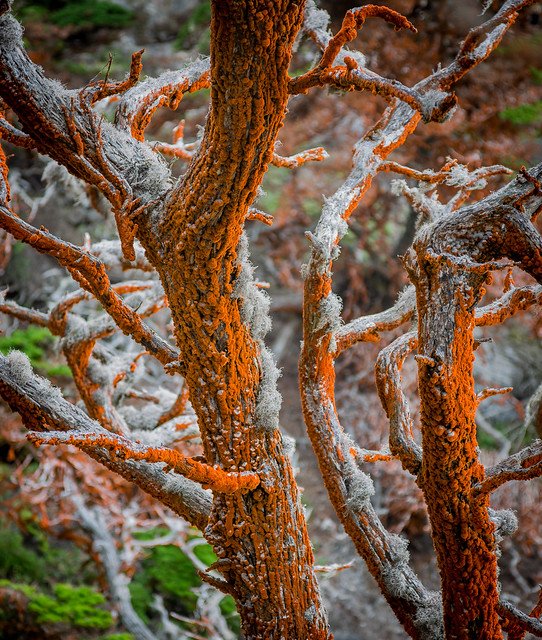Trentepholia and its relationship with trees
In the world of symbiotic relationships, nature never fails to surprise us. One such intriguing partnership exists between trees and a type of green alga known as Trentepohlia. While often overlooked, this symbiosis plays a crucial role in ecosystems worldwide. In this article, we'll delve into the fascinating world of Trentepohlia and its intricate relationship with trees.
Trentepohlia sp. on Cryptomeria japonica bark - Photo: B.navez
What is Trentepohlia?
Trentepohlia is a genus of green algae belonging to the family Trentepohliaceae. These algae are typically found growing on the bark of trees, rocks, and other surfaces in damp and shaded environments. They are characterised by their vibrant orange, red, or yellow coloration, which is due to the presence of carotenoid pigments.
Photo: Chris Axe
Relationship with Trees:
The relationship between Trentepohlia and trees is mutualistic, meaning both parties benefit from the association. Trentepohlia thrives in the moist and nutrient-rich environment provided by the tree bark. In return, the algae contribute to the health and well-being of the tree in several ways:
1. Photosynthesis: Like all plants, Trentepohlia is capable of photosynthesis, converting sunlight into energy and producing oxygen as a byproduct. By colonizing tree bark, these algae contribute to the overall photosynthetic activity of the ecosystem, helping to maintain oxygen levels and remove carbon dioxide from the atmosphere.
2. Moisture Regulation: Trentepohlia forms a dense mat or layer on the surface of tree bark, which helps to retain moisture and prevent desiccation. This is particularly important in arid or drought-prone environments, where moisture retention can be crucial for the survival of trees and other vegetation.
3. Nutrient Cycling: As Trentepohlia photosynthesises and grows on the tree bark, it absorbs and accumulates nutrients from the surrounding environment. When the algae die or are consumed by other organisms, these nutrients are released back into the ecosystem, contributing to nutrient cycling and the fertility of the soil.
4. Protection: The presence of Trentepohlia on tree bark can also provide a degree of protection against environmental stressors such as extreme temperatures, UV radiation, and pathogens. The dense algal mat acts as a physical barrier, shielding the underlying bark from damage.
Ecological Significance:
The relationship between Trentepohlia and trees has significant ecological implications. By enhancing nutrient cycling, moisture retention, and overall ecosystem productivity, these algae contribute to the health and resilience of forest ecosystems. They also serve as food sources for a variety of organisms, including insects, snails, and other invertebrates, forming the basis of complex food webs.
Furthermore, Trentepohlia biofilms on tree bark can have aesthetic value, contributing to the beauty and diversity of forest landscapes. Their vibrant colours add visual interest to tree trunks and branches, particularly in areas with high humidity and rainfall.
Hells Gate New Zealand Photo : @the_wanderer_photographer
In conclusion, Trentepohlia represents a fascinating example of symbiosis in nature, highlighting the interconnectedness of living organisms within ecosystems. By forming mutually beneficial relationships with trees, these algae play a vital role in maintaining the health and vitality of forest ecosystems worldwide. As we continue to study and appreciate the complexities of these relationships, we gain a deeper understanding of the intricate web of life that sustains our planet.
Trentepholia at one of Tasmanias most beautiful attractions - Bay Of Fires - Photo : Diego Delso
One last thing…
While Trentepohlia is primarily known for its symbiotic relationship with trees, it has also been utilised as a natural navigation tool. Sailors and travellers have historically used the presence of Trentepohlia and other moss, algae and lichens on the southern sides of trees and rocks as a crude indicator of direction, particularly in regions where compasses may be unreliable or unavailable. The tendency of Trentepohlia to thrive in moist, shaded environments often results in its preferential growth on the south-facing surfaces of substrates. By observing the distribution of Trentepohlia, navigators can infer approximate cardinal directions, aiding them in orienting themselves within their surroundings. (Note: Here in Australia would see this happen on the southern side, whereas in the northern hemisphere it would occur more frequently on the northern side ;) )




